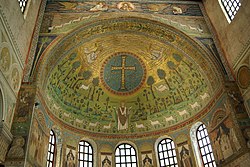- A Celtic-style cross from the Nestorian Evangelion.
- A sun cross carved on a Yuan-dynasty Nestorian tombstone. (Inner Mongolia)
History

The nimbus or ringed shape was appended to the Christian cross and other symbols relatively early. In these contexts it apparently derived from the earlier Roman garland of victory. The Chi Rho-in-circle motif was widespread in the Roman Empire by the late 4th century, and garlanded and ringed crosses were popular in imperial Ravenna by the 5th century, influencing the later versions. [1] The cruciform halo or cross halo, a halo incorporating a cross, emerged as a distinctive type of halo painted behind the head of members of the Holy Trinity, especially Jesus, and occasionally others. [2] In other cases, the combination of cross and nimbus symbolized the presence of Christ throughout the cosmos, with the nimbus representing the celestial sphere. Notable early examples include the cosmological ringed cross in the 5th-century Mausoleum of Galla Placidia, and the 6th-century Crux Gemmata in the Basilica of Sant'Apollinare in Classe. [3]
Coptic cross
Old Coptic crosses often incorporate a circle, as in the form called a "Coptic cross" by Rudolf Koch in his The Book of Signs (1933). Sometimes the arms of the cross extend through the circle (dividing it into four quadrants), as in the "Celtic cross". The circle cross was also used by the early Gnostic sects.
Nestorian cross
Crosses used by the Church of the East sometimes incorporate a circle, similar to the Celtic cross or a sun cross.

























